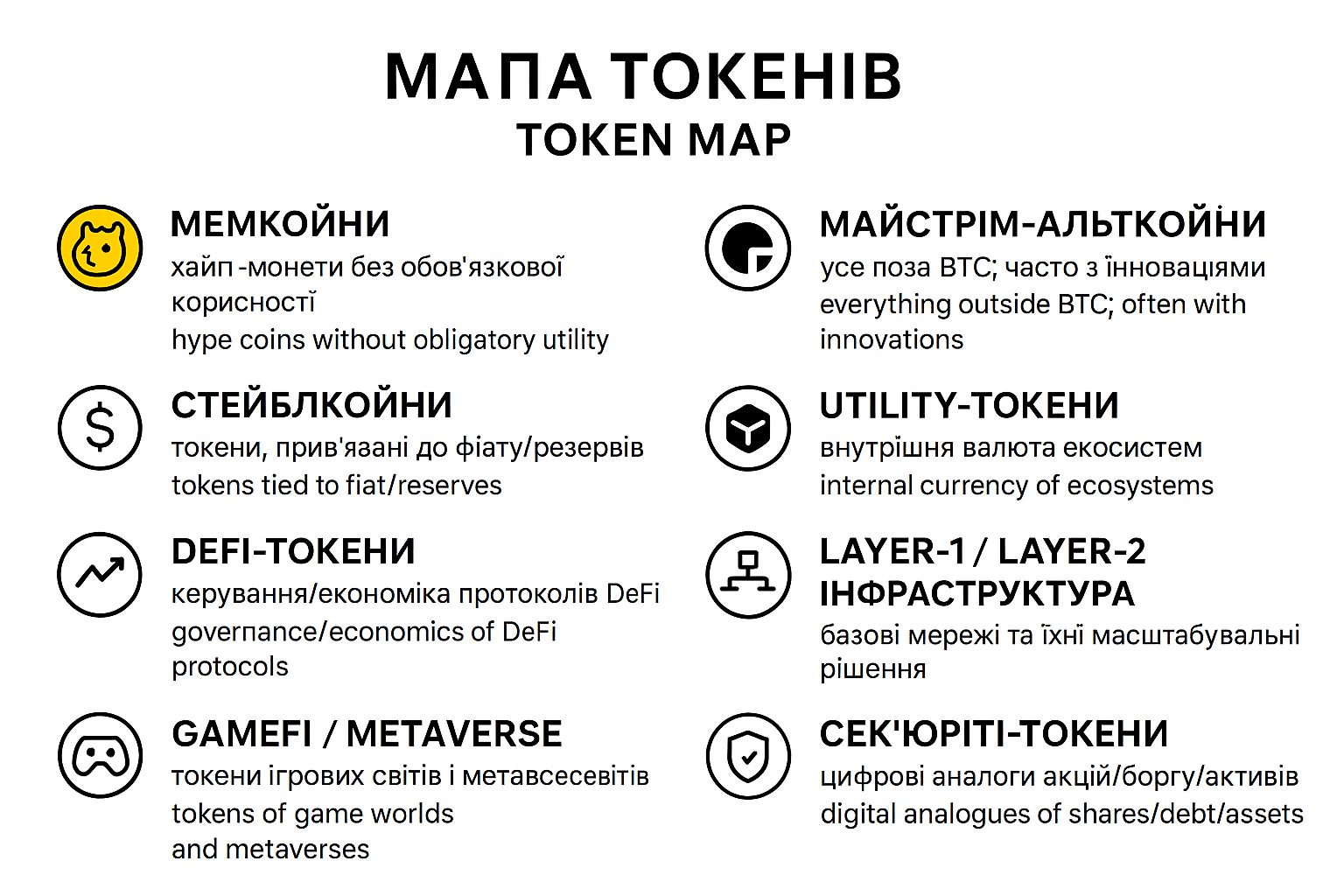Token map: type → nature → support → fate in 3–5 years → trader's action
1) #Мемкойни ($DOGE , SHIB, PEPE etc.)
What it is: hype coins without mandatory utility.
Origin: joke/meme → viral spread.
Support: influencers, social media, community.
3–5 years: most disappear/wither; a few become 'iconic'.
Risk/advantage: extreme volatility / quick impulses.
Trader's move: only speculatively, small % of the portfolio; enter on the hype wave — exit quickly.
2) #Альткойни mainstreams (ETH, $SOL , BNB, ADA, AVAX…)
What it is: everything outside BTC; often innovative (smart contracts, L1/L2).
Origin: tech products of teams/funds.
Support: dev teams, infrastructure, partners.
3–5 years: some lose interest; 20–30% hold; 5–10% become leaders.
Risk/advantage: market cycles / best balance of growth and liquidity.
Trader's move: core portfolio medium-term; selection based on technology, network effects and liquidity.
3) #Стейблкойни (USDT, $USDC , DAI…)
What it is: tokens tied to fiat/reserves.
Origin: issuing companies or DeFi protocols.
Support: reserves/collateral, regulatory reputation.
3–5 years: mostly stable; sometimes failures/de-pegs occur.
Risk/advantage: counterparty/regulatory risk / liquidity stability.
Trader's move: portfolio 'cash', parking capital, hedging volatility.
4) #Utility tokens (BNB, APE, SAND, MATIC as utility)
What it is: internal currency of ecosystems (fees, access, NFTs, voting).
Origin: exchanges/platforms/gaming worlds.
Support: product utility + active ecosystem.
3–5 years: live alongside the platform: grow or disappear with it.
Risk/advantage: dependency on a single product / demand within the network.
Trader's move: invest if you believe in the platform (usage metrics, burning, fee-sink).
5) DeFi tokens (UNI, AAVE, GMX, MKR…)
What it is: governance/economics of DeFi protocols (DEX, lending, derivatives).
Origin: open protocols, DAO.
Support: protocol revenue, TVL, user activity.
3–5 years: those with sustainable fee metrics (fee, buyback, real useful product) survive.
Risk/advantage: technical/smart contract risks / on-chain transparency and yield.
Trader's move: look at TVL, volumes, fee generation and tokenomics (buyback, real utility).
6) Layer-1 / Layer-2 infrastructure (SOL, AVAX, OP, ARB, Base ecosystem)
What it is: base networks and their scaling solutions.
Origin: high-tech teams, investors.
Support: dev activity, number of dApps, TPS/fees, partnerships.
3–5 years: strong networks strengthen, weak ones merge liquidity.
Risk/advantage: competition for devs/users / large network effects.
Trader's move: bet on ecosystems with real user and dev inflow.
7) GameFi / Metaverse (SAND, MANA, AXS…)
What it is: tokens of gaming worlds and metaverses.
Origin: game studios + crypto economy.
Support: gameplay, game economics, community.
3–5 years: many fade away; few survive with real gameplay, not just a token.
Risk/advantage: cyclicality of trends / spikes on releases and collaborations.
Trader's move: track release calendars, MAU/DAU, on-chain economy.
8) Security tokens (tokenized securities, real-world assets)
What it is: digital analogs of stocks/debt/assets (mostly outside mass market).
Origin: regulated platforms, institutions.
Support: legal infrastructure, custody, compliance.
3–5 years: slow but steady growth; little of interest for speculation.
Risk/advantage: regulatory barriers / predictability.
Trader's move: not a main tool for public exchange strategies.
How it reads 'in practice': what usually happens in 3–5 years
Meme coins: 9 out of 10 disappear; a few remain iconic.
Mainstream altcoins: some grow into 'titans', some lose liquidity.
Stablecoins: maintain parity; issuer risks — rare but critical in failures.
Utility/DeFi/L1-L2: survive networks/protocols with real metrics (users, fee, TVL); others degrade.
Short advice for a long-term concept (3–5 years)
Portfolio architecture: 50–70% mainstream alt+infra, 20–40% stables (cash and risk management), ≤5% memes as volatility options.
Project selection: utility metrics (DAU/MAU, TVL, fee), tokenomics (burning/buyback, inflation, unlock schedule), partnerships.
Risk management: watch for unlocks, keep liquidity in stables, use any-time exit plans.
Market cycles: scale positions in bearish phases; in bullish — lock profits in parts.
Discipline: trading journal, entry/exit rules, pre-defined triggers (price, volume, news).


